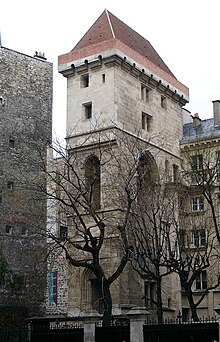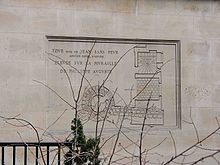Hotel de Bourgogne (Paris)
The Hôtel de Bourgogne was the residence of the Dukes of Burgundy in Paris until the end of the 15th century and, in this function, was at times the center of power in France during the conflicts between the Armagnacs and the Bourguignons .
In the 16th and 17th centuries, the same name was used to refer to the Théâtre de l'hôtel de Bourgogne , a forerunner of the Comédie-Française ( Lage ).
Both buildings, the palace and the theater, are in the street that is now called Rue Etienne Marcel .
Hotel de Bourgogne
The Hôtel de Bourgogne was built in 1270 as the Hôtel d'Artois for Robert II of Artois , the nephew of Louis the Saint, directly on the outside of the city wall of Philip Augustus . In 1318 the marriage between Johanna III. , Countess Palatine of Burgundy and Countess of Artois, and Odo IV. , Duke of Burgundy, in the possession of the Burgundians. Their heir, Duke Philip the Bold , made the hotel his main residence in 1402.
After the murder of his cousin, Duke Ludwig von Orléans , in 1407, Philip's son Johann Ohnefurcht ( French: Jean sans Peur ) had the Tour Jean sans Peur built in the center of the building as a retreat in 1408 , the tower named after him, which is the only one Rest of the Hôtel de Bourgogne is still visible today.
The Hôtel de Bourgogne remained residence until the dukes were inherited by the Habsburgs .
Théâtre de l'hôtel de Bourgogne
In 1548, the Confrères de la Passion et de la Résurrection de Notre Seigneur Jésus-Christ built a theater on Rue Mauconseil (today Rue Etienne Marcel), diagonally across from the Hôtel de Bourgogne, to perform mystery games there - the Confrères had the monopoly in Paris for theatrical performances and rented their houses to traveling theater troupes. The first performance took place on August 30, 1548.
In 1624, Pierre Le Messier and his own troupe settled in the Théâtre de l'hôtel de Bourgogne. In 1628 Valleran Le Conte established here under the protection of Louis XIII. his troupe royale . The program consisted of farces by Turlupine , Gros-Guillaume and Gautier-Garguille , tragedies by Alexandre Hardy and Jean Rotrou , and a little later by Corneille and Racine . In 1647 Floridor moved from Théâtre du Marais to the Hôtel de Bourgogne to take over the management. During this time, the great interpreters Montfleury and Champmeslé appeared here.
In 1660, the Comédie-Italienne shared the Hôtel de Bourgogne with the Troupe royale for a time. In 1680, the Troupe royale and the troupe of the Hôtel de Guénégaud merged, which had already emerged from the merger of the Théâtre du Marais with the Troupe Molières : an order from Louis XIV created a single and permanent drama group, the Comédie-Française .
literature
- Antoine Adam, Histoire de la littérature française au XVIIe siècle , Volume 1, Paris, Albin Michel, 1997 (1st edition 1948) ISBN 2-226-08910-1
- Arnaud Alexandre, Les Hôtels princiers , in Frédéric Pleybert (ed.), Paris et Charles V, arts et architecture , Paris, Action artistique de la ville de Paris, 2001, ISBN 2-913246-29-X
- Philippe Chauveau, Les Théâtres parisiens disparus (1402-1986) , ed. by l'Amandier, Paris, 1999, ISBN 2-907649-30-2
- André Degaine, Histoire du théâtre dessinée , Nizet, 1992, ISBN 978-2-7078-1161-5
- Henri Lacaille, Étude sur le Collège de Reims à Paris, 1412-1763 , in Travaux de l'Académie de Reims , CIV, 1897–98
Web links
Coordinates: 48 ° 51 ′ 51.6 ″ N , 2 ° 20 ′ 53 ″ E


